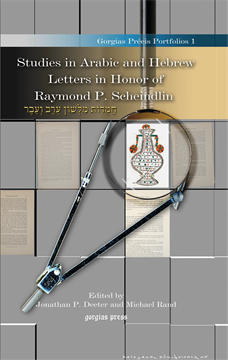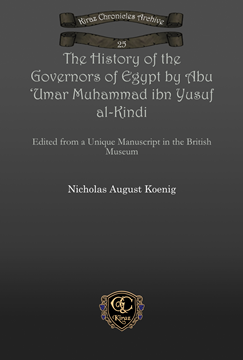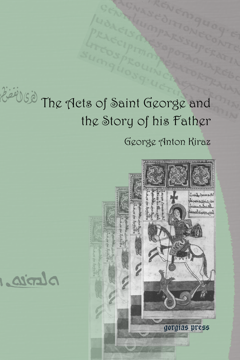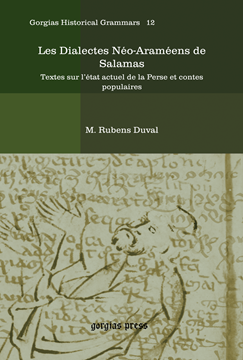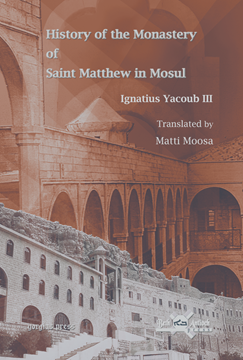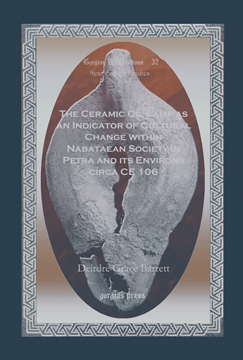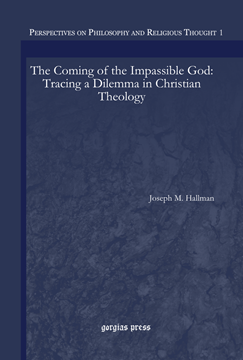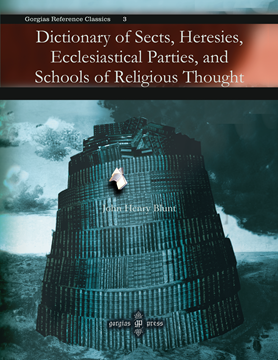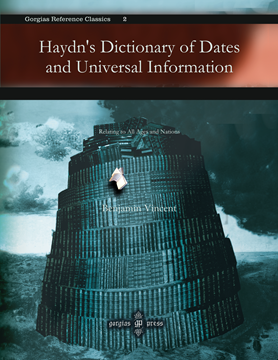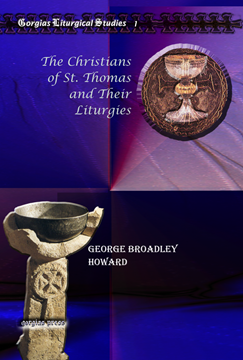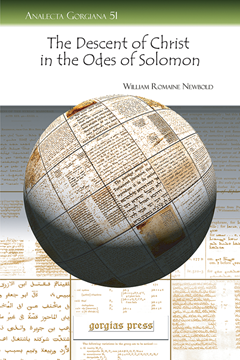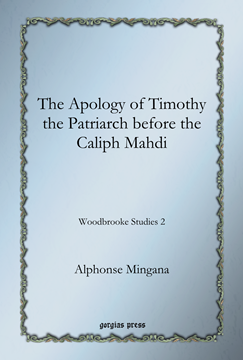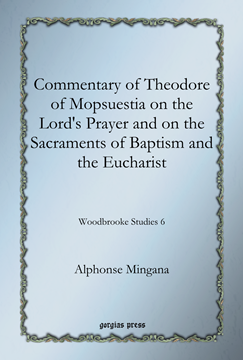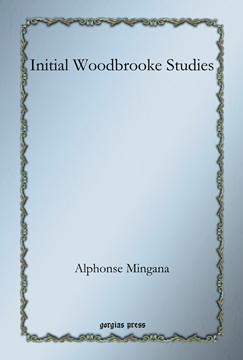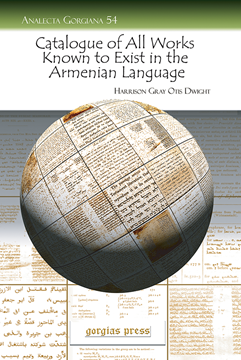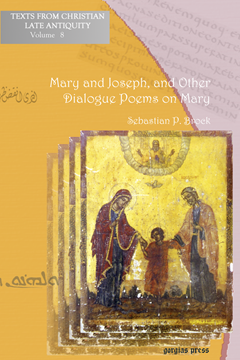Studies in Arabic and Hebrew Letters in Honor of Raymond P. Scheindlin
Edited by Jonathan P. Decter; By Michael Rand
Series: Gorgias Précis Portfolios 1
ISBN: 978-1-59333-701-8
This volume contains contributions, in English and Hebrew, on the following topics: Biblical criticism, Medieval Biblical lexicography, Classical and Post-Classical piyyut, Medieval Hebrew poetry and science, Judeo-Arabic poetry and epistolography, Classical Arabic poetry and prose, and the history of Jewish Studies in America.
$164.00 (USD)
The History of the Governors of Egypt by Abu 'Umar Muhammad ibn Yusuf al-Kindi
Edited from a Unique Manuscript in the British Museum
Series: Kiraz Chronicles Archive 25
ISBN: 978-1-59333-766-7
Published for the first time in this book is the History of the Governors of Egypt by Abu Umar Muhammad ibn Yusuf al-Kindi (d. 870). Edited from a single manuscript by Nicholas Koenig, this study is as close as possible to a critical edition when only one manuscript survives.
$102.00 (USD)
Tracing the Bridegroom in Dura
The Bridal Initiation Service of the Dura-Europos Christian Baptistery as Early Evidence of the Use of Images in Christian and Byzantine Worship
ISBN: 978-1-59333-738-4
This book examines the previously unexplored sources of the eleventh-century Byzantine service of Christ the Bridegroom by locating its origins in the liturgical environment of third-century Christian Syria and Mesopotamia, and especially in the baptistry of the Christian House at Dura-Europos, as well as in the texts of the Acts of Thomas, the Gospel of Philip and the Symposium by Methodius of Olympus. More specifically, Pagoulatos analyzes the bridal initiation service (the earliest known Iconophile service) of the Dura-Europos baptistery, focusing on the role that the images played in it.
$78.00 (USD)
The Acts of Saint George and the Story of his Father
From the Syriac and Garshuni Versions
ISBN: 978-1-59333-784-1
One of the most enduring of the saints, Saint George has seldom failed to capture the imagination of Christian readers, both ancient and modern. The Acts of Saint George, originally written in Greek, quickly spread to many linguistic traditions in the church of late antiquity. Presented here in vocalized Syriac and Arabic, the original text of the Acts is made easily accessible to readers of these languages. A detailed introduction in English summarizes the hagiography for those unacquainted with the Semitic languages. The account follows the hagiographic practice of describing the trials, steadfast faith, and martyrdom of the saint. Also included is the story of the father of Saint George, recorded in Syriac.
$60.00 (USD)
A History of Christian Missions in China
ISBN: 978-1-59333-786-5
Starting with the religious background of China, Latourette probes why Christianity appealed to the Chinese and then launches into a detailed history of its development. He considers how Christianity began before and coped under the Mongol Dynasty and then the incursion of the Roman Catholic Missions. Briefly considering the Russian Orthodox interest in Chinese missions, he moves on to what is clearly his main concern in the Protestant influx in the nineteenth and early twentieth centuries. Considering the main events of China’s history in relation to the European powers of the day, he considers how Christianity fared into the early nineteenth century.
$314.00 (USD)
Les Dialectes Néo-Araméens de Salamas
Textes sur l’état actuel de la Perse et contes populaires
Series: Kiraz Historical Grammars Archive 12
ISBN: 978-1-59333-787-2
This specialized study by renowned linguist Rubens Duval brings together several grammatical studies between its covers. For the most part this intriguing volume is an exploration of the dialects of Neo-Aramaic of Salmas in the area of Azerbaijan and northwest Iran. Duval transcribed in handwritten, Roman characters, the aural information he received in the region from Syrian Christians and Jews. These are translated into French, making access to the linguistic information available to non-Semitic specialists. Duval concludes the book with an article on Syriac inscriptions of Salmas. This book is very rare in the used book market.
$165.00 (USD)
History of the Monastery of Saint Matthew in Mosul
Translated by Matti Moosa
ISBN: 978-1-59333-788-9
Located north of Mosul, St. Matthew’s Monastery—commonly known as Dayr Sheikh Matti—is perhaps the most ancient religious institution in Iraq. Although the Syriac life story of St. Matthew was published together with that of St. Behnam by Paul Bedjan in 1891, and translated into Arabic by Elias Behnam, this present account is more extensive and informative. It includes in-depth physical and spiritual descriptions of the monastery as an outstanding institution which played a significant role in the history of the Syrian Orthodox Church of the East. Mar Ignatius Jacob III offers insight into the monastery’s learned superiors, metropolitans and magnificent library.
$145.00 (USD)
The Ceramic Oil Lamp as an Indicator of Cultural Change within Nabataean Society in Petra and its En
ISBN: 978-1-59333-628-8
How did the Nabataeans view their world at the time of the Roman annexation in CE 106? If it is possible to detect an altered perception after their monarchy was dissolved at that time, how can we be sure it was authentic and not a veneer, masking the identity of a disaffected people? One approach is to consider religious practice as a diagnostic for identity within Nabataean society. Religious practice is examined through the ceramic oil lamp, a ubiquitous vessel that can portray socio-political and religious symbolism and cultural hybridization.
$134.00 (USD)
Tracing a Dilemma in Christian Theology
ISBN: 978-1-59333-792-6
This book describes the development of the Christian understanding of God from the second to the eighth century as witnessed by major theologians who gradually realized that the Incarnate Word made flesh was not the God of the philosophers. They helped construct the great dogmas of the Christological councils. Beginning with the Apologists and ending with Maximus Confessor, the theological tradition overcame the notion of impassible deity in favor of the humble God of Christian faith, the Word made flesh.
$139.00 (USD)
Dictionary of Sects, Heresies, Ecclesiastical Parties, and Schools of Religious Thought
Series: Kiraz References Archive 3
ISBN: 978-1-59333-796-4
In an attempt to organize the swiftly-growing diversity in Christianity during the nineteenth century, the author compiled a learned compendium of the known religious groups of his day. A unique glimpse into the history of early-modern religious thought, this reference work includes extensive articles on the various collections of believers both Christian and non-Christian. Blunt, in a move that presaged the more comprehensive modern studies of the phenomenon of religious diversification, included exotic religions that were beginning to be taken seriously during his century.
$244.00 (USD)
Haydn's Dictionary of Dates and Universal Information
Relating to All Ages and Nations
Series: Kiraz References Archive 2
ISBN: 978-1-59333-797-1
This book was so popular during the lifetime of the original author that it went through six editions. This reprinting of the acclaimed seventeenth edition of Vincent’s revision of Haydn’s work is a delightful reminder of the basic information that was considered so important during the advent of the classic encyclopedias and reference works being produced in the nineteenth century. Arranged alphabetically, this historic work contains hundreds of articles that pertain to important dates and events in human history.
$281.00 (USD)
The Christians of St. Thomas and Their Liturgies
Series: Kiraz Liturgical Studies 1
ISBN: 978-1-59333-800-8
Originally written to inspire sympathy for their Eastern Christian compatriots among the membership of the Church of England, Howard’s study has become a touchstone for those seeking a sense of antique Christian liturgical practice. After providing a history of the “St. Thomas Christians,” the Orthodox Christians of India, up until the mid-nineteenth century, Howard presents English translations of six different anaphorae in use in Christendom: namely, those of St. James, St. Peter, The Twelve Apostles, Mar Dionysius Barsalibi, Mar Xystus, and Mar Evannis.
$171.00 (USD)
Christian Writers on Judaism
Nineteen Centuries of Apologetics and Polemics
By George Moore
Series: Analecta Gorgiana 49
ISBN: 978-1-59333-864-0
Geroge Foot Moore’s Christian Writers on Judaism is a fundamental work which majestically traverses nineteen centuries of Christian literature regarding the Jews. This work is indispensable to the student of Jewish-Christian dialogue.
$45.00 (USD)
The Descent of Christ in the Odes of Solomon
Series: Analecta Gorgiana 51
ISBN: 978-1-59333-866-4
This title explores the implications of the Descent of Christ in the twenty-third Ode in regards to astrology and Gnostic thought and supports the thesis of the author’s earlier work that the Odes emerged from a Judaeo-Christian, Mesopotamian setting.
$41.00 (USD)
The Apology of Timothy the Patriarch before the Caliph Mahdi
Woodbrooke Studies 2
ISBN: 978-1-59333-827-5
Part of Alphonse Mingana’s “Woodbrooke Studies” (of which the present book is volume 2), The Apology of Timothy the Patriarch before the Caliph Mahdi is accompanied in this volume by The Lament of the Virgin and The Martyrdom of Pilate. The namesake of the volume, Timothy’s apology for Christianity, is an eighth-century manuscript and one of the earliest documents concerning Christianity’s relationship with Islam. The Lament of the Virgin is Mary’s sadness at the empty tomb; in this piece she is conflated with Mary Magdalene. The Martyrdom of Pilate presents Pontius Pilate as a saint and lays out his spiritual accomplishments that are crowned by his martyrdom.
$167.00 (USD)
A Syriac Valentinian Hymn
An Excerpt from Epiphanius' Panarion
Series: Analecta Gorgiana 52
ISBN: 978-1-59333-867-1
Epiphanius, the great fourth century heresiographer, included in his discussion of the Valentinians an excerpt from a manuscript, of which Newbold here provides the Greek text and the Syriac original, along with his translation, textual notes and commentary.
$90.00 (USD)
Commentary of Theodore of Mopsuestia on the Nicene Creed
Woodbrooke Studies 5
ISBN: 978-1-59333-828-2
The Commentary of Theodore of Mopsuestia on the Nicene Creed is an important document of an instrumental age in the development of Christianity. Theodore (c. 350-428) was clearly the most important biblical scholar of his age. While his theology eventually led to his loss of favor among some branches of the church, Theodore was at least partially responsible for three church councils held to deal with his ideas, including those of Ephesus and Chalcedon. Mingana has published here, as Woodbrooke Studies 5, for the first time a document that had previously been lost and which contains Theodore’s observations on the outcome of the Council of Nicaea, the Nicene Creed.
$145.00 (USD)
The Work of Dionysius Barsalībi Against the Armenians
Woodbrooke Studies 4
ISBN: 978-1-59333-829-9
The Work of Dionysius Barsalībi Against the Armenians represents the nature of some disputes in the Christianity of the Middle Ages. Dionysius Barsalībi (d. 1171) in a very rare manuscript, begins by giving a brief sketch of the political and religious history of the Armenians. Dionysius argues that Christ’s body was corruptible up until the time of his death, and only after that did it become incorruptible. This underscores the fact that Christ had a true human body and that he digested food just like other people. The implications for this interpretation in connection with the Eucharist are obviously essential aspects to be resolved in this controversy.
$118.00 (USD)
Commentary of Theodore of Mopsuestia on the Lord's Prayer and on the Sacraments of Baptism and the E
Woodbrooke Studies 6
ISBN: 978-1-59333-830-5
The Commentary of Theodore of Mopsuestia on the Lord’s Prayer and on the Sacraments of Baptism and the Eucharist is an important witness to the development of Christianity. Theodore (c. 350-428) was clearly the most important biblical scholar of his age. In a series of six homilies Theodore here addresses the Lord’s Prayer as a springboard to discuss what actually constitutes prayer. His homilies on the sacraments are essential witnesses to the historical development of these sacraments. His work here is basically a commentary on the text of the liturgy, an awareness of the centrality of the sacraments to the life of the church in his age.
$155.00 (USD)
Initial Woodbrooke Studies
Woodbrooke Studies 1
ISBN: 978-1-59333-832-9
The initial installments of Alphonse Mingana’s “Woodbrooke Studies: Christian Documents in Syriac, Arabic, and Garshūni, edited and translated with a critical apparatus,” began as articles within the Bulletin of the John Rylands Library Manchester, starting in volume 11. In this initial foray into publishing the manuscripts in his personal collection, Mingana offers translations and critical comments on seven documents: A Treatise of Barsalībi against the Melchites; Genuine and Apocryphal Works of Ignatius of Antioch; A New Jeremiah Apocryphon; A New Life of John the Baptist; Some Uncanonical Psalms; the Vision of Theophilus; and the Apocalypse of Peter.
$188.00 (USD)
Ascetic Strains in Early Judaism
Series: Analecta Gorgiana 53
ISBN: 978-1-59333-868-8
Reviewing the relevant Jewish and Christian literature the author demonstrates that though there is no mandate for ascetic practice within early Judaism, there is a deep respect there for an ascetic way of life.
$41.00 (USD)
Das Sendschreiben des Patriarchen Barschuschan an den Catholicus der Armenier
The Circular Letter of the Patriarch Bar Shushan to the Catholicos of Armenia
By Otto Lichti
Series: Analecta Gorgiana 50
ISBN: 978-1-59333-865-7
This work provides the Syriac text, with a German introduction and translation, of John Bar Shushan’s treatise attacking the Melkite tradition, upholding the Creed of Faith, defending the Syrian Orthodox preparation of the Eucharist, and criticizing Armenian Church practices.
$48.00 (USD)
Catalogue of All Works Known to Exist in the Armenian Language
Up to the Seventeenth Century
Series: Analecta Gorgiana 54
ISBN: 978-1-59333-869-5
This work provides a summary, short author biography, and reference to editions or translations of all the works of Armenian provenance known to the author. It concludes with works of Greek Church Fathers and secular literature preserved in Armenian.
$90.00 (USD)
A Call to Covenant Love
Text Grammar and Literary Structure in Deuteronomy 5–11
Series: Gorgias Biblical Studies 30
ISBN: 978-1-59333-674-5
Profound in its conclusions and targeted toward the exegete, this volume offers a clear method for establishing flow of thought, text hierarchy, and literary macrostructure in biblical Hebrew prose. The study contributes both to hermeneutical theory and to the study of Deuteronomy by arguing for the application of discourse linguistics alongside stylistic and semantic analysis in the interpretation of OT texts. It includes a brief literary-structural and theological commentary on Deuteronomy 5–11 that models the text grammatical approach and shows its benefits for exegesis.
$189.00 (USD)
Mary and Joseph, and Other Dialogue Poems on Mary
Series: Texts from Christian Late Antiquity 8
ISBN: 978-1-59333-839-8
What was Joseph’s reaction when he arrived home to find Mary pregnant? How did Mary manage to persuade him that her child was none other than the Son of God? The Syriac literary tradition had a unique way of answering these sorts of questions raised by the Bible. Dialogue poems (sughyotho) offer lively, thought-provoking, and often delightful re-imaginings of Biblical events. They expand the Biblical stories, giving the familiar characters more dialogue and describing their inner thoughts. The collection provides five dialogue poems featuring Mary, in Syriac original with facing English translation.
$40.00 (USD)
